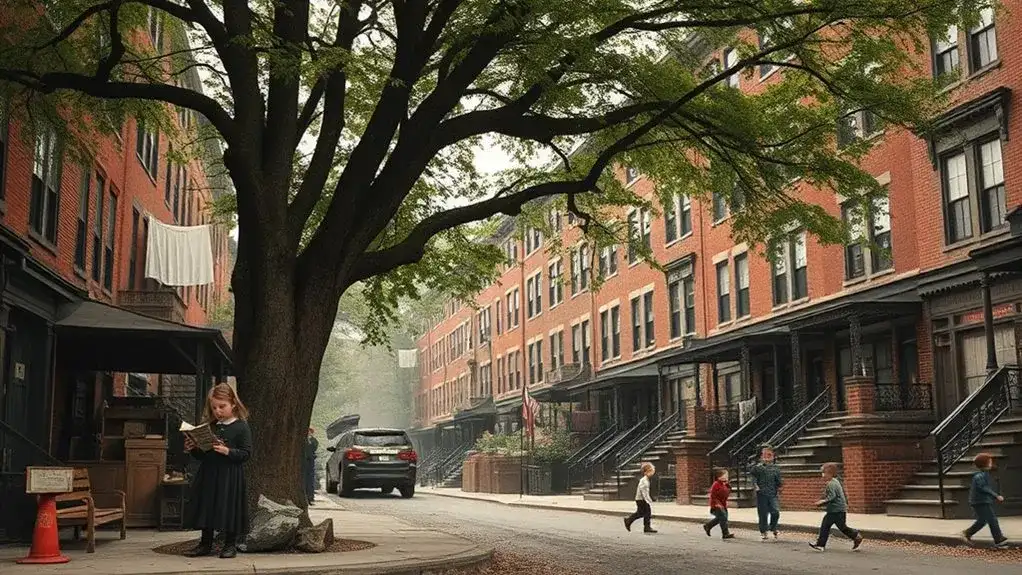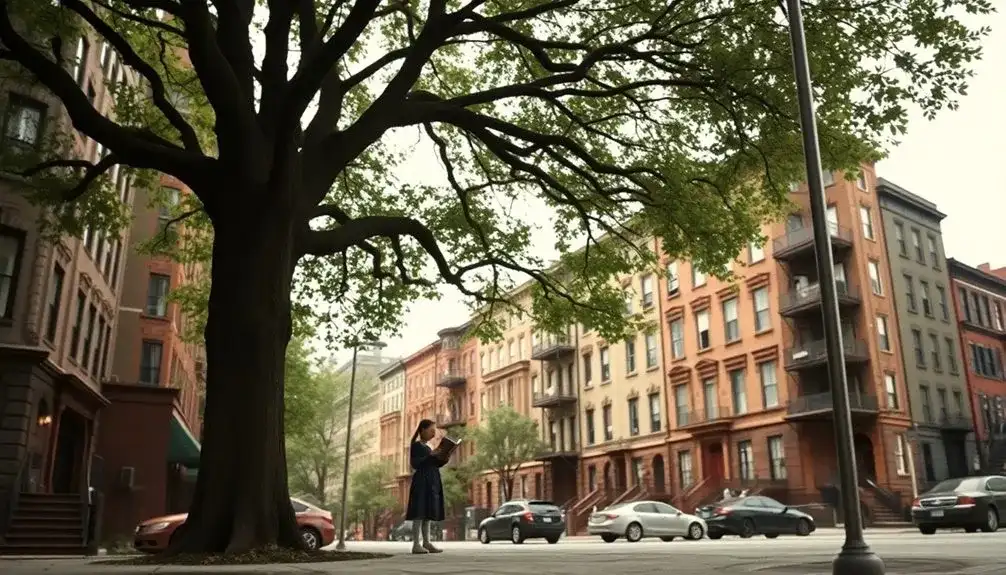Betty Smith’s A Tree Grows in Brooklyn, first published in 1943, is a powerful coming-of-age story that chronicles the life of Francie Nolan, a young girl growing up in the tenements of Williamsburg, Brooklyn, during the early 20th century. Set against the backdrop of a rapidly changing urban landscape, the novel explores themes of resilience, the transformative power of education, familial love, and the enduring pursuit of the American Dream. Drawing on Smith’s own impoverished childhood, the narrative is rooted in reality yet imbued with a universal message that continues to resonate across generations.
This analysis expands upon the key elements of the novel, integrating a detailed exploration of its plot, themes, characters, historical context, and cultural impact. By examining Francie Nolan’s journey in-depth, we uncover a rich portrait of human perseverance that mirrors the tenacity of the Ailanthus tree — the ‘tree of heaven’ — which serves as a poignant symbol throughout the book.
Overview of the Novel

A Tree Grows in Brooklyn invites readers into the world of Francie Nolan, a bright and imaginative girl who grows up amidst the grit and hardship of Brooklyn’s Williamsburg neighborhood. The story spans the years 1912 to 1918, a period marked by industrialization, World War I, and massive waves of immigration. Against this setting, Francie’s personal growth unfolds with emotional depth and subtlety.
Smith’s narrative is episodic, relying less on dramatic action and more on the accumulation of detail and emotional insight to create a sense of realism. Through daily experiences—collecting junk for pennies, attending school, interacting with family members—Francie’s inner world becomes a lens through which the broader realities of working-class immigrant life are portrayed.
The novel traces Francie’s journey from childhood to early adulthood. Her emotional and intellectual development is framed by her relationship with her family: Katie, her strong-willed and pragmatic mother; Johnny, her charming but unreliable father; her brother Neely; and her unconventional Aunt Sissy. Each character plays a significant role in shaping Francie’s identity and worldview.
By centering the story on Francie’s internal growth and external struggles, Smith offers a nuanced portrait of life in Brooklyn during the early 20th century. Her slow-moving yet immersive style invites readers to invest emotionally in the characters and their day-to-day lives, reinforcing the book’s themes of endurance and hope.
Author’s Background and Literary Influences
To fully appreciate A Tree Grows in Brooklyn, it is essential to understand the life and perspective of its author, Betty Smith. Born Elisabeth Wehner in 1896 to German immigrants in Brooklyn, Smith’s upbringing was marked by poverty, instability, and a thirst for education.
Smith’s early experiences closely mirrored those of her protagonist. Like Francie, she grew up in Williamsburg, surrounded by tenement buildings and struggling families. Her father died when she was young, and her mother worked tirelessly to support the family. These biographical details infuse the novel with authenticity and emotional depth.
Smith’s passion for literature and education was a defining feature of her youth. She devoured books and pursued writing, eventually studying journalism and playwriting. Her achievements include winning the prestigious Hopwood Award for creative writing while attending the University of Michigan.
Although A Tree Grows in Brooklyn was her first novel, it became an instant success. Smith’s portrayal of working-class life resonated deeply with readers, particularly during World War II. The emotional honesty of her work, coupled with its realistic detail, helped to establish her as a significant literary voice.
Smith’s writing aligns with a tradition of social realism found in the works of Charles Dickens and Theodore Dreiser. Like these authors, she used fiction to illuminate the struggles of the marginalized. Her ability to elevate the ordinary into the profound helped define her legacy as a major figure in American literature.
Major Themes in A Tree Grows in Brooklyn

1. Resilience in the Face of Adversity
One of the most enduring themes in A Tree Grows in Brooklyn is resilience. Francie’s life is fraught with obstacles—poverty, hunger, humiliation, and the loss of loved ones—but she continually finds ways to rise above these hardships. Her resilience is echoed in the Ailanthus tree growing outside her tenement window: a tree that thrives even in the most unlikely and inhospitable environments.
Throughout the novel, Francie learns to find strength in small victories. Her desire to read every book in the public library, her efforts to attend a better school, and her determination to support her family are all manifestations of her inner resolve.
Katie, too, exemplifies resilience. As the family’s primary provider, she works tirelessly as a janitress to keep food on the table and a roof over their heads. Her brand of quiet strength and practicality contrasts with Johnny’s charm but lack of dependability.
2. The Transformative Power of Education
Education is portrayed as the great equalizer in A Tree Grows in Brooklyn. For Francie, books and learning are not merely academic pursuits—they are lifelines. Her education enables her to articulate her thoughts, question her surroundings, and imagine a future beyond the tenement walls.
The novel illustrates the barriers that children from impoverished backgrounds face in accessing quality education. Francie’s initial experience at a local school is disheartening due to overcrowding and poor teaching. However, her persistence and Katie’s support eventually help her transfer to a better school, where she begins to thrive.
Education also serves as a means of personal liberation. Francie’s growing literacy allows her to reinterpret her circumstances and assert her independence. The emphasis on self-improvement underscores a broader message: knowledge is a tool for empowerment.
3. Complex Family Dynamics
Smith paints a multifaceted portrait of family life. The Nolan family is held together by love but strained by hardship. Francie’s relationship with her parents is particularly complex. She idolizes Johnny despite his alcoholism, while struggling to understand Katie’s stern demeanor and preference for Neely.
Katie’s relationship with Francie is marked by both affection and emotional distance. She loves Francie deeply but is often more nurturing toward Neely, whom she sees as more vulnerable. This favoritism creates tension but also spurs Francie’s quest for validation and self-worth.
Aunt Sissy, with her string of failed marriages and unconventional lifestyle, provides a contrasting perspective on family and womanhood. Her loyalty and love for Francie highlight the importance of chosen family and support systems.
4. The Immigrant Experience and the American Dream
As a depiction of early 20th-century immigrant life, A Tree Grows in Brooklyn captures the tension between aspiration and reality. The characters navigate linguistic, cultural, and economic barriers as they strive for upward mobility.
The American Dream—the belief that hard work will lead to success—is scrutinized in the novel. While some characters achieve modest improvements in their circumstances, others, like Johnny, succumb to the weight of unmet expectations.
Francie’s dream of becoming a writer symbolizes the possibility of transcendence, but Smith makes it clear that such achievements require extraordinary perseverance.
Character Analysis

Francie Nolan
Francie is the heart of the novel. Intelligent, sensitive, and introspective, she is a keen observer of her environment. Her transformation from a curious child to a mature young woman is central to the novel’s emotional core. Francie’s resilience, imagination, and unwavering belief in the power of education make her an inspiring figure.
Katie Nolan
Katie is both the emotional anchor and the primary breadwinner of the family. Practical and stoic, she often suppresses her emotions to protect her children. Her relationship with Francie is complicated by favoritism and unspoken expectations, but her love is ultimately unwavering.
Johnny Nolan
Charming and musically gifted, Johnny is beloved but unreliable. His alcoholism and inability to provide for his family lead to his early death, but his warmth and encouragement have a lasting impact on Francie.
Neely Nolan
Neely represents a more traditional male path through poverty. He benefits from Katie’s favoritism and eventually secures a stable job, but lacks Francie’s introspective depth and ambition.
Aunt Sissy
Sissy is a symbol of unconditional love and resilience. Her unconventional choices and personal struggles make her a vibrant character who brings levity and warmth to the narrative.
Historical and Cultural Context
The setting of A Tree Grows in Brooklyn is essential to understanding its characters and themes. Williamsburg in the early 20th century was a hub for immigrant families struggling to make ends meet. The tenement lifestyle—overcrowded housing, inadequate sanitation, and limited opportunities—defined daily life for many.
The novel also captures broader historical events, including World War I and the rise of labor movements. These events form the backdrop against which personal stories unfold. Smith integrates these historical details subtly, grounding the novel in a specific time and place without overwhelming the narrative.
Gender roles, too, are a crucial aspect of the cultural context. Women like Katie had limited options and were expected to prioritize family above all else. Smith critiques and complicates these expectations through her portrayal of strong, multifaceted female characters.
Legacy and Impact
Since its publication, A Tree Grows in Brooklyn has been celebrated for its honest depiction of poverty and its affirmation of human dignity. The novel sold nearly three million copies in its first two years and has remained in print ever since. It has been translated into 16 languages and adapted into both a film and a Broadway musical.
Despite being dismissed by some early critics as overly sentimental, the novel has since been recognized as a classic. It appears regularly on school reading lists and continues to inspire readers with its message of resilience and hope.
The New York Public Library named it one of the “Books of the Century,” a testament to its enduring relevance. The novel’s impact is not only literary but also cultural—it helped shape the narrative of American identity and perseverance.
Conclusion
Betty Smith’s A Tree Grows in Brooklyn is more than a tale of a girl growing up in poverty—it is a profound meditation on the human spirit. Through Francie Nolan’s eyes, we witness the complexities of family, the necessity of resilience, and the transformative power of education.
Just like the Ailanthus tree that grows in the most unwelcoming of places, Francie thrives amidst adversity. Her journey is not merely about survival but about growth, understanding, and self-realization.
This timeless novel continues to resonate because it speaks to universal truths. In its pages, readers from all walks of life find echoes of their own struggles and dreams. In celebrating the ordinary and elevating the overlooked, Betty Smith created a work that transcends its setting to become a cherished piece of American literature.



